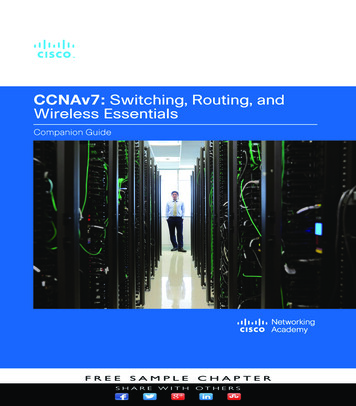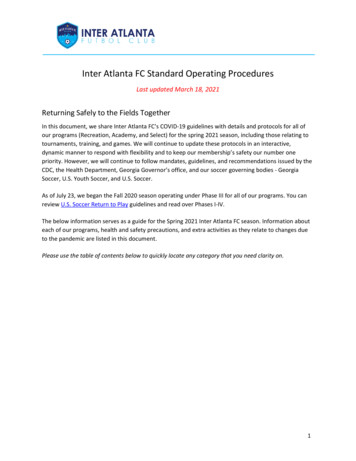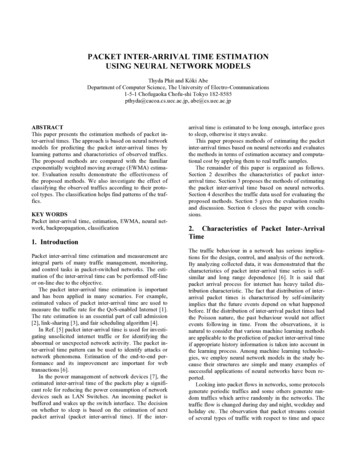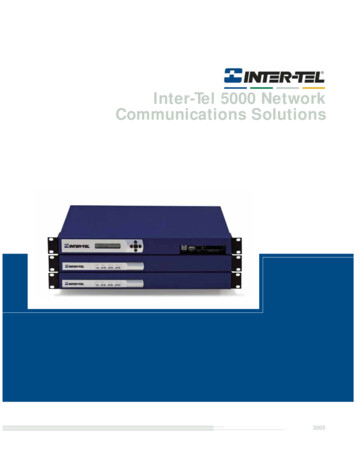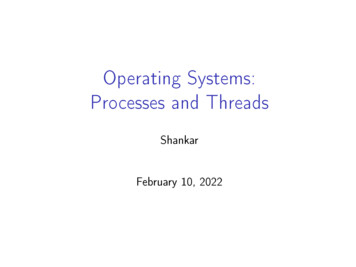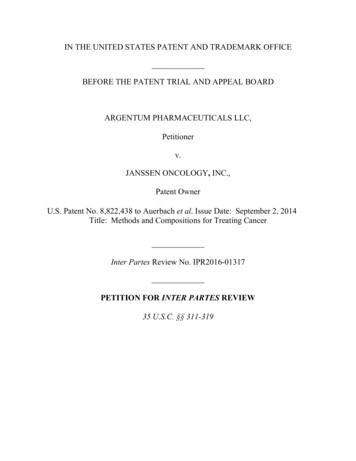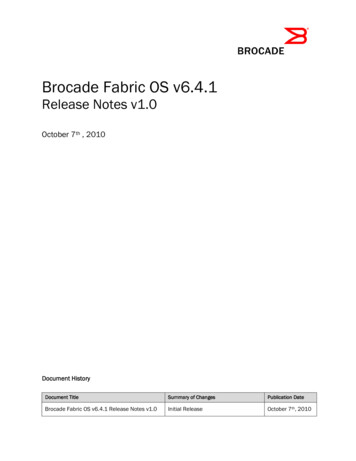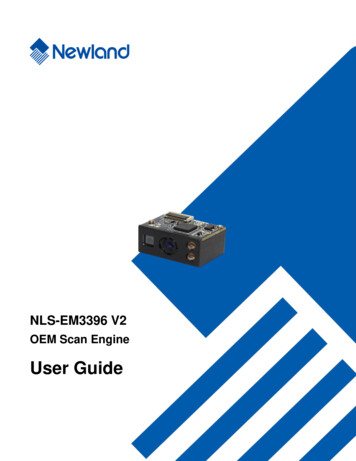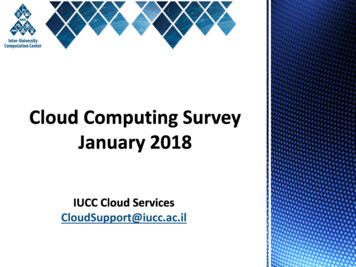
Transcription
CloudSupport@iucc.ac.il
Overview Date:January 2018 Population:Representatives of IT departments from 6 Israeli institutions Objective:Evaluate how and to what extend cloud computing is used inacademic institutions in Israel. Next Steps:Align IUCC’s offering to the areas indicated that require more effort inorder to take the institutions to the next level in cloud usage.2
Cloud Service Providers46% - Amazon Web Services (AWS)31% - Microsoft Azure15% - Google Cloud PlatformWhich cloud service provider(s) are your university or researcherscurrently using?Amazon Web Services (AWS)Microsoft AzureGoogle Cloud Platform (GCP)OracleIBMOther CSPNot using any cloud service3
Training and Education38% - Self-study / hands-on experience23% - Classroom-based training23% - Official cloud vendor documentation15% - Online coursesHow did you learned to work with the cloud?Classroom-based trainingOnline course (Udemy, ACloud Guru, Cloud Academy, etc.)Official cloud vendors documentationSelf-study / hands on experience4
Environment Deployment and Management37% - Windows25% - RedHat / CentOS12% - Ubuntu12% - SUSE Linux12% - Amazon LinuxWhat operating systems are you currently deploying in thecloud?WindowsRedHat / CentOSUbuntuSUSE LinuxAmazon LinuxOther operating system5
Environment Deployment and Management (cont.)42% - Environments deployed by faculty IT departments28% - Environments deployed byuniversity IT departments28% - Environments deployed directly by researchersWho deploy and maintain environments in the cloud?The university IT departmentThe faculty IT departmentThe researchers themselves6
Environment Deployment and Management (cont.)50% - Deploy new machines manually25% - Use cloud built-in automation tools13% - Deploy new virtual machines on premise andHow do you deploy new environments in the cloud?import into the cloud13% - Have no virtual machines inthe cloudI don't have any virtual machine in the cloudManual deployments of new virtual machines in the cloudInstall virtual machines on premise and import the VM’s into the cloudUse cloud built-in automation tools (AWS CloudFormation, Azure Resource Manager, etc.)Use configuration management tools (Chef, Puppet, Ansible)7
Use of Automation Tools42% - Use web management console17% - Use PowerShell or Bash scripts17% - Use cloud vendor CLI tools17% - Use other scripting languagesHow do you manage your environments in the cloud?I don't have any virtual machine in the cloudUsing the cloud providers web management consoleUsing PowerShell or Bash scriptsUsing cloud vendor built-in CLI tools (AWS CLI, Azure CLI, gcloud CLI)Other scripting language8
Use of Automation Tools (cont.)80% - Not using any automation tools20% - Azure Resource ManagerWhat automation tools / cloud deployment templates areyou currently using (or planning to use in the next 12months)?AWS CloudFormationAzure Resource ManagerGoogle Cloud Resource ManagerNone of the above9
Use of Automation Tools (cont.)71% - Not using any configuration management tools14% - Azure Automation14% - SaltstackWhat configuration management tools are you currentlyusing (or planning to use in the next 12 months)?ChefPuppetAnsibleSaltstackAWS OpsWorksAzure AutomationNone of the above10
Use of Databases in the Cloud71% - Not using any relational database in the cloud14% - Using MySQL14% - Using PostgreSQLWhat relational database are you currently using in the cloud?Microsoft SQL ServerOracleMySQLPostgreSQLMariaDBNone of the above11
Use of Databases in the Cloud (cont.)83% - Not using any managed database service17% - Using Azure SQLHow do you deploy relational databases?I am installing a database server inside a virtual machineAmazon RDSAzure SQL or Azure Database (for PostgreSQL, MySQL, MariaDB)Google Cloud SQL (for PostgreSQL and MySQL)None of the above12
Use of Databases in the Cloud (cont.)83% - Not using any NoSQL database in the cloud17% - Using MongoDBWhat NoSQL database are you currently using in the cloud?MongoDBCassandraAmazon DynamoDBAzure CosmosDBGoogle Cloud DatastoreNone of the above13
Use of Container Technology50% - planning to use containers in the next 12-24 months33% - Currently using virtual machines instead of containers17% - Don’t have any environments in the cloudAre you currently using containers?I don't have any environment in the cloudYesNo, I am currently using virtual machinesI am planning on using containers in the next 12-24 months14
Use of Containers Technology (cont.)50% - Using or learning to use Docker containers50% - Not using container technology at allWhat container platform are you currently using?DockerCoreOSLXCLXDOther container platformI am not using containers15
Use of Containers Technology (cont.)50% - Not using container technology at all33% - Using Kubernetes (or planning to use it in the next 12-24 months)17% - Planning to use other container orchestration technologyWhat container orchestration platform are you currently using?Docker SwarmKubernetesMesosAmazon ECSAmazon EKSAzure Container InstancesAzure Container Service (AKS)Google Container EngineOther orchestration platformI am not using containers16
Use of Serverless Technology83% - Currently not using any Serverless technology16% - Using Azure FunctionsAre you currently using Serverless computing (or planning to usein the next 12-24 months)?NoAWS LambdaAzure FunctionsGoogle Cloud FunctionsOther Serverless technology17
Use of Cloud Storage38% - Using Dropbox31% - Using Google Drive23% - Using Microsoft OneDrive8% - Using BoxWhat free file storage services are you using?BoxDropboxGoogle DriveMicrosoft OneDrivepCloudOther file storage service18
Use of Cloud Storage (cont.)43% - Not using any cloud managed storage service29% - Using Amazon S329% - Using Azure Blob storageWhat cloud storage services are you using?Amazon S3Azure Blob StorageGoogle Cloud StorageOther cloud storage serviceNone of the above19
Use of Messaging and Collaboration Services40% - Using Microsoft Office 365 (Mostly for University usage)40% - Using Google G Suite (Mostly for the students)20% - Using on-premises Exchange serverWhat messaging platform are you currently using?On premise Microsoft ExchangeAmazon WorkMailMicrosoft Office 365Google G SuiteOther messaging platform20
Use of Identity and Authentication Services71% - Authentication based on NetIQ Identity Manager14% - Authentication based on Azure Active Directory14% - Authentication based on local username and passwordsWhat identity and authentication service are you using?Local username and passwordAWS IAMAzure Active DirectoryGoogle Cloud IAMNetIQ Identity ManagerOther federation service21
Demands for High Availability and Fail-over:100% - Currently there are no requirements for high availabilityHow do you handle high availability?I have no requirement for high availabilityCurrently I do not have any solution for high availabilityI am deploying multiple servers in multiple regions/availability zones/availability sets22
Demands for High Availability and Fail-over (cont.)100% - Currently there are no requirements for fail-overHow do you handle failover?I have no requirement for failoverCurrently I do not have any solution for failoverAmazon Elastic Load BalancingAzure Load BalancerGoogle Cloud Load BalancingI am depending on built-in application load-balancing capabilitiesI have developed my own application load-balancerI am using 3rd party load-balance solution (such as F5 BIG-IP)Other load-balancing solution23
Monitoring of Cloud Environments85% - Not monitoring the environments in the cloud14% - Using built-in cloud monitoring toolsAre you currently monitoring your cloud environment resources?NoI am using open source monitoring tools (such as Nagios, etc.)I am using 3rd party monitoring tools (HP OpenView, Microsoft SCOM, CA Nimsoft, etc.)I am using the built-in cloud monitoring tools (Amazon CloudWatch, Azure Monitor, Google StackDriver, etc.)24
Monitoring of Cloud Environments (cont.)100% - Not monitoring the cloud environments for security incidentsAre you currently monitoring your cloud environments for securityincidents?NoI am currently using open source tools (such as Syslog, etc.)I am using the built-in cloud monitoring tools (Amazon CloudTrail, Azure Operational Insights)25
Management of DNS Services100% - Are managing their DNS services by themselvesHow do you manage your DNS services?I manage my own DNS serversMy ISP is managing my DNS serversAzure DNSGoogle Cloud DNSAmazon Route5326
Conclusions In most of the cases, cloud environments are deployed and maintainedby the University IT departments or by the faculty IT personnel. Technical workshops on the necessary tools and knowledge on working,deploying and maintaining cloud environments are crucial to enable ITdepartments/personnel to support the Universities and researchersdemands Both Microsoft and AWS agreed to support and fund workshops in allthe Universities. Currently, most of IaaS cloud environments are deployed manually, andIT personnel lack knowledge in cloud automation tools. Almost none of the Universities use advanced technologies such ascontainers and Serverless.27
Conclusions (cont.) Almost none of the Universities are using managed-services (such asdatabase, authentication, DNS, etc.) Most of the Universities are using cloud storage services (such asDropbox, Google Drive, OneDrive, etc.) due to previous agreementswith the cloud vendors. Most of the Universities are using managed messaging services (such asOffice 365 and Google G Suite), due to agreements with the cloudvendors. None of the Universities are using cloud environments for productionuse, and as a result, currently there are no demands for high availability,fail-over and monitoring (either infrastructure or security).CloudSupport@iucc.ac.il28
Use of Identity and Authentication Services 71% - Authentication based on NetIQ Identity Manager. 14% - Authentication based on Azure Active Directory. 14% - Authentication based on local username and passwords . Almost none of the Universities use advanced technologies such as containers and Serverless. 27. Conclusions (cont.)
